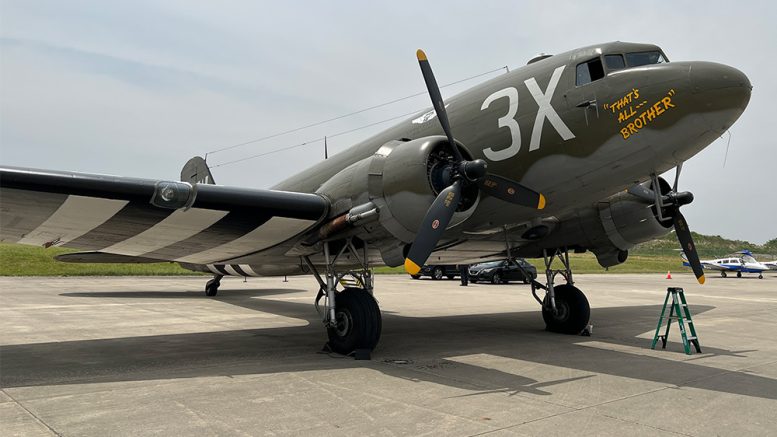See & touch World War II aircraft today & Thursday
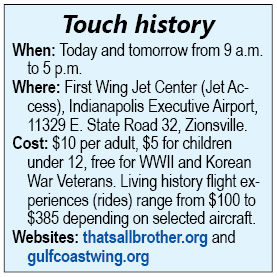 Last October, some readers may recall when Reporter Publisher Stu Clampitt was stuck in the 1920s and, among other 1920s experiences, he flew in one of the world’s first commercial airliners, a Ford Tri-Motor 5-AT, a plane flown by both Amelia Earhart and Charles Lindbergh.
Last October, some readers may recall when Reporter Publisher Stu Clampitt was stuck in the 1920s and, among other 1920s experiences, he flew in one of the world’s first commercial airliners, a Ford Tri-Motor 5-AT, a plane flown by both Amelia Earhart and Charles Lindbergh.
Thanks to an invitation from Experimental Aircraft Association President Nick Boland, we sent our extremely acrophobic publisher into the skies again this week to commemorate the 79th anniversary of D-Day in the very troop transport that led the invasion over Normandy on June 6, 1944.
“That’s All … Brother” is the C-47A Skytrain troop transport that led the Allied Airborne Invasion over Normandy on D-Day. Today and tomorrow “That’s All … Brother” sits with two other historic planes at Indianapolis Executive Airport, 11329 E. State Road 32, Zionsville. You can see this piece of history for $10 and fly in either the C-47A, a twin-engine JRB Navy transport, or – for the more daring among you – an SNJ/T-6 Texan advanced trainer.
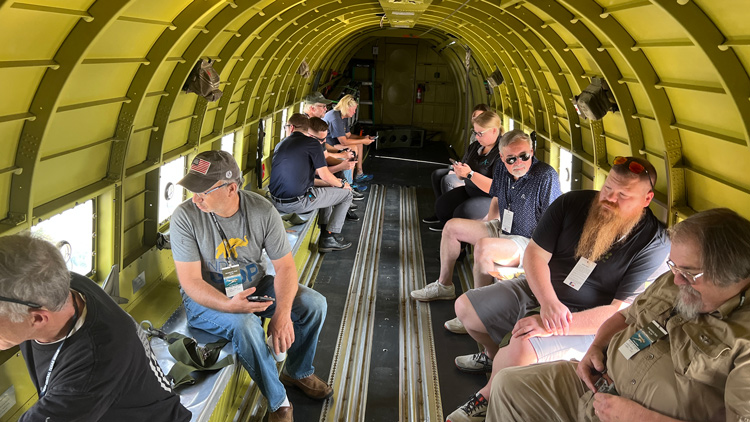
Reporter photo by Stu Clampitt
C-47 “That’s All … Brother”
“That’s All … Brother” is a C-47 military aircraft. In civilian life the same airframe is a DC-3.
“‘That’s All … Brother’ came off the assembly line in April of 1944, went straight over to Europe, and ended in England,” Commemorative Air Force Education (CAF) Officer and Rides Coordinator Bill Krammerer told The Reporter. “The plane ended up becoming the lead aircraft of 821 planes that went across the channel dropping over 11,000 paratroopers on the night of D-Day.”
“Bell of Birmingham” was originally slated to be the lead aircraft, but it didn’t have the advanced equipment needed to follow the pathfinders which had been laid out for the pre-dawn D-Day flight.
According to Krammerer, most C47s carry 14 or 15 paratroopers, but “That’s All … Brother” held less because of the weight of the extra tracking equipment and the size of the crew.
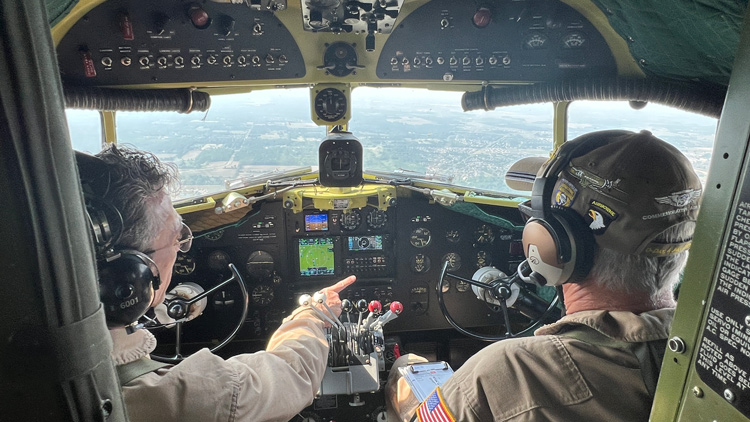
A view from behind the cockpit while flying in this historic plane on the anniversary of D-Day. (Reporter photo by Stu Clampitt)
“That’s All … Brother” was named by the crew as a message to Hitler. After the end of WWII, it was forgotten and slated to be scrapped in an aircraft boneyard until someone researched the tail number and realized this was D-Day’s lead plane.
Neither the Air Force Museum in Dayton, Ohio, nor the Smithsonian were willing to take on the job of restoring it, so CAF stepped up and held a fundraiser to bring it back into service.
“They spent two and a half to three million dollars restoring it, completely stripped it down to bare frame,” Krammerer said. “Everything was inspected so basically it was a new plane built and started building in 2015.”
In 2019, “That’s All … Brother” returned to Normandy to fly at the 75th anniversary of D-Day.
The restoration process included sourcing or re-manufacturing all the original equipment and even the original paint job. This includes an error on the nose. On one side of the nose, the opening quotation mark in the name, “That’s All … Brother” is missing, as it was in 1944.
The black and white “invasion stripes” were a way to allow Allied anti-aircraft to identify friendly planes. That paint scheme was kept secret until two days before D-Day, when all 821 planes needed to be painted before the allied invasion. In the rush and with limited supplies, the stripes were painted on with brushes, rags, mops, and anything else available.
“That’s All … Brother” has intentionally messy edges on the invasion stripes, and the restorers even left a small patch of green on the left side of the plane, just behind the door, that was missed in the rush job in 1944.
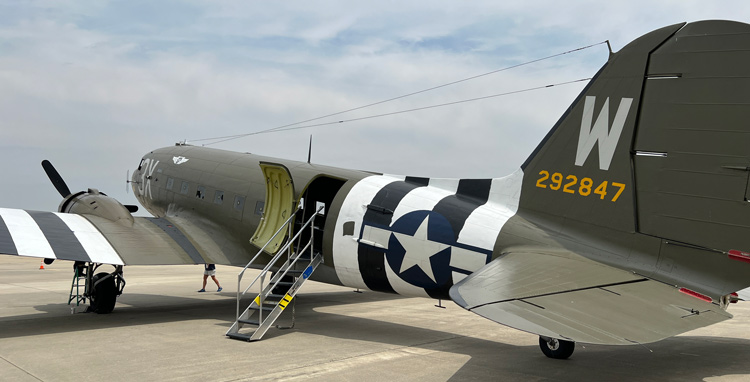
If you look closely, you can see a patch of the stripe behind the door on “That’s All … Brother” is unpainted, just like it was on D-Day 79 years ago. (Reporter photo by Stu Clampitt)
Gulf Coast Wing’s C-45
“Our C-45 from World War II was painted in Navy colors, so the Navy would have called it a JRB,” Brian Kossier told The Reporter.
The Beechcraft Model 18 (C-45) is a twin-engine, low-wing, tailwheel light aircraft manufactured by the Beech Aircraft Corporation of Wichita, Kan. Continuously produced from 1937 to November 1969, over 9,000 were built, making it one of the world’s most widely used light aircraft.
“We have it set up as an Admiral transport, so it’s the nicest warbird ride you could ever take, with a leather interior,” Kosier said. “These were a very, very versatile aircraft. They could be used as trainers. When the cadets got out of the AT-6s – single-engine trainers – and wanted to fly something heavier like the C-47 or the B-17s, they would go into this aircraft for multi-engine training.”
The C-45 was also used in other training roles, aside from pilot training.
“They could also be used for long-distance navigation training,” Kosier said. “They could be modified, put a glass dome, or a glass nose on, and they would use for bombardier training. They could also put a turret on the top, about midship, and they would be used for air gunnery practice. So they filled lots of training roles, as well as moving cargo and small amounts of troops around. The plane allowed them to get in and out of short runways, as well as moving high brass to base to base.”
The C-45 Beechcraft can take up to five passengers. Four people can ride in the back for $100 each and a co-pilot seat is available for $200.
Through Thursday, June 8, you can book flights in advance at gulfcoastwing.org or in-person at the Indianapolis Executive Airport, 11329 E. State Road 32, Zionsville.
Our acrophobic publisher was not quite up for a ride in the AT6 Texan/SNJ, but if you take that flight, The Reporter would be happy to talk to you about your experience.
Reporter photos

